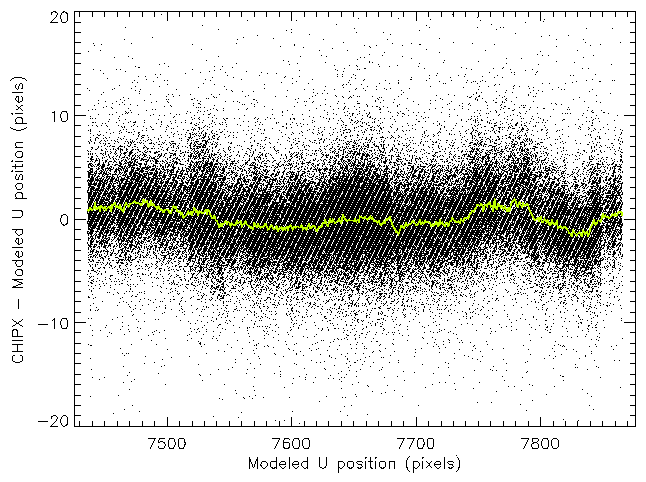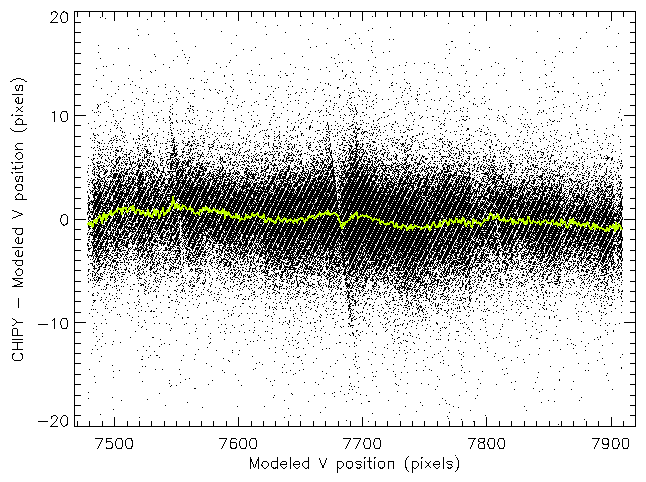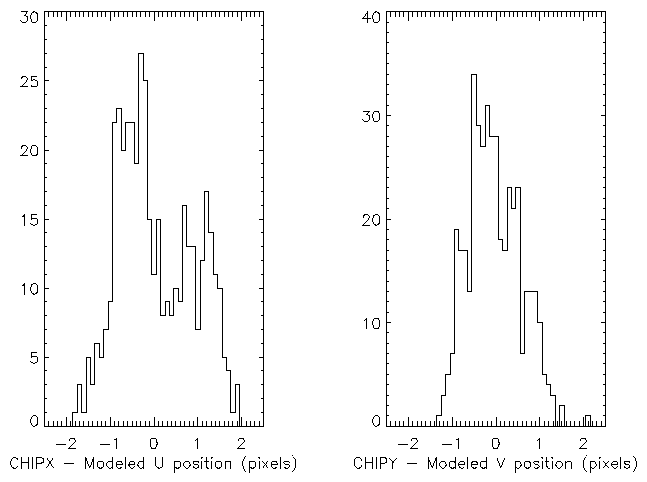Blur from Residual Errors in HRC Event Position Reconstruction
Introduction
The HRC event positions are not telemetered to the ground but must be
reconstructed from data generated by the HRC crossed-grid charge
detector (CGCD) (see
memo HRC Position Logic).
In reconstructing the event positions corrections for
ringing in
amplifiers and
degapping are
applied. The detector positions that result are then combined with
information on the position and motion of the detector behind the
HRMA and with the telescope aspect solution to determine a
celestial location for each event. The quality of the resulting
images is determined by the combination of "blur" from several
sources: the PSF of the HRMA, the aspect solution, the intrinsic
resolution of the HRC detector, and the HRC event position
reconstruction. In this memo I will address the last of these
contributors. An earlier version of this
memo, written prior to some improvements in HRC-I degapping,
showed a greater contribution from event position
reconstruction; this update documents the improvement.
Figure 1 demonstrates the result of event position reconstruction
errors. Using data from ObsID 1385 (a ~19ks observation of AR Lac),
reprocessed with the most recent calibration products, I have
selected events from within a 20 pixel radius centered on the
source and plotted the "Sky" X and Y positions versus time. The
wobble that is apparent in the mean position as a function of
time is indicative of an error in either the aspect
reconstruction or the HRC event position reconstruction.Since
this sort of wobble is not observed in ACIS observations, it is
logical to attribute it to dithering over the residual errors in
the determination of HRC event positions.

|
|
Figure 1: Events within 20 pixels of AR Lac: X and Y plotted
versus time.
|
HRC Position Errors
Residual errors in the HRC positions are the likely cause of the
apparent wobble observed in Figure 1. We can use the spacecraft
dither as a probe of the position errors as a function of detector
position by using the aspect solution to model the expected
location of the source on the HRC detector. Starting from the
aspect solution file and the nominal pointing direction, I modeled
the expected time history of the location of AR Lac on the
HRC detector (U and V axes) including the motion of the detector
behind the HRMA. Then for each event I calculated the model
position by linear interpolation of location time history. Plotted
in figure 2 is the deviation of the corrected (de-rung and
degapped) event position from the modeled event position as a
function of modeled position for the HRC U-axis; figure 3 is
similar but for the V-axis. There is a natural width to the
deviations which is due to the HRMA, aspect reconstruction, and
intrinsic HRC detector blur but the systematic wave as a function
of modeled position is indicative of errors in the HRC event
position reconstruction. The size of this systematic
error is shown in the over-plotted yellow curve which is the mean
of the observed deviation as a function of modeled position.

|
|
Figure 2: Observed deviations from modeled event position on
the HRC U-axis. The yellow curve is the average
deviation at each modeled position.
|

|
|
Figure 3: Observed deviations from modeled event position on
the HRC V-axis. The yellow curve is the average
deviation at each modeled position.
|
Figure 4 shows a plot of the histograms of the mean deviations.

|
|
Figure 4: Histograms of the deviations from modeled event
positions for the U-axis (left) and the V-axis
(right).
|
Conclusions
The fact that there is a systematic trend in the deviations from
modeled position as a function of modeled positions demonstrates
that even with the most up-to-date calibration HRC event position
reconstruction may be a significant contributor to the overall
PSF. Whether further improvements to the de-ringing or degapping
corrections can be found that reduce the size of this contribution
is unknown.
Back to my memos page
Michael Juda
email Mike Juda
Last modified: Fri Oct 24 10:42:57 EDT 2008




